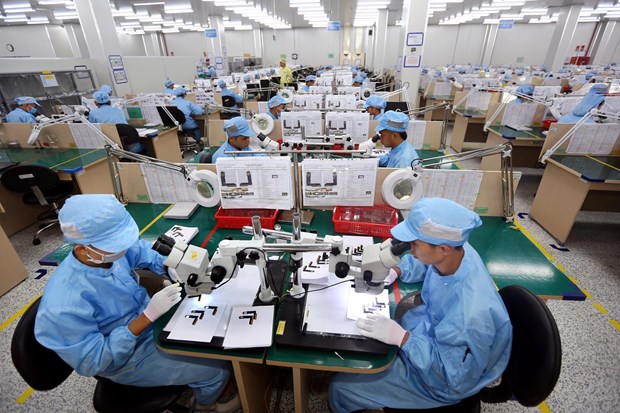 Economy
Economy


|
| Workers examine electronic components at the factory of the Young Poong Electronics VINA Co. Ltd in Bình Xuyên II Industrial Park, in the northern province of Vĩnh Phúc Province. — VNA/VNS Photo |
The year 2019 closed with remarkable achievements for Việt Nam's economy, building a steady foundation for sustainable development. The Vietnam News Agency has selected the top 10 outstanding economic events of the year.
1. GDP growth rate among fastest in the region
In 2019, Việt Nam posted gross domestic product (GDP) growth of 7.02 per cent amidst growing competition in the region and the world. This is the second straight year the country has fulfilled all 12 targets set by the National Assembly, including a record trade surplus of US$9.94 billion, total registered foreign direct investment capital of $38.02 billion – a 10-year high, low budget overspending, and inflation under 3 per cent. This is also the fourth consecutive year inflation has been kept below 4 per cent.
2. Việt Nam inks free trade, investment protection deals with EU
On June 30, the EU-Vietnam Free Trade Agreement (EVFTA) and Investment Protection Agreement (IPA) were signed in Hà Nội. Under the EVFTA, the two sides pledge to slash nearly 100 per cent of import tariffs, the strongest cut among the FTAs Việt Nam has signed. The IPA also holds significance as it helps ensure an open and better investment and business climate for investors from around the globe.
3. Politburo issues first resolution on foreign investment attraction
On August 20, the Politburo issued Resolution 50-NQ/TW, setting up plans for perfecting institutions and policies and improving the quality and effectiveness of foreign direct investment (FDI) attraction until 2030. The first issuance of a resolution on FDI was praised by both domestic and foreign investors. It details Việt Nam priorities in FDI attraction, which are projects that apply new, high and clean technologies, have modern governance methods and high added value, and connect with global production and supply chains.
4. Việt Nam jumps 10 places in Global Competitiveness Report
On October 9, the World Economic Forum (WEF) released a report which showed Việt Nam had jumped 10 places on the Global Competitiveness Index from 77th in 2018 to 67th in 2019, making the country the most improved in the rankings. This is the first time Việt Nam has moved to the upper half of the list of 141 economies.
5. African swine fever spreads nationwide
On February 19, the Ministry of Agriculture and Rural Development reported the appearance of African swine fever in Việt Nam. This is a dangerous disease with no vaccine or treatment available. The ministry said there has never been an epidemic that has caused such widespread damage. By mid-December, nearly six million pigs had been culled, accounting for about 9 per cent of the nationwide herd. The epidemic has led to a pork shortage, pushing pork prices up in the final months of the year.
6. New-style rural area building completed two years ahead of schedule
On October 19, the Central Steering Committee for the national target programme on new-style rural area building held a conference to review the programme in 2010-20. The programme has given a facelift to Vietnamese countryside, raising farmers’ stature, improving rural living standards and restructuring agricultural production towards modernity and sustainability. By October, 4,665 communes, or 52.4 per cent of the total nationwide, had been recognised as new-style rural areas, 2.4 per cent higher than the target. Prime Minister Nguyễn Xuân Phúc has called on localities and sectors to continue with the work in 2021-25.
7. Banks race to increase charter capital
In 2019, an array of commercial banks moved to raise charter capital to ensure their capital adequacy ratio (CAR) meets requirements set by the State Bank of Việt Nam to reach Basel II standards from January 1, 2020. Eighteen banks have satisfied Basel II standards so far, including 16 domestic and two foreign institutions. Basel II has the highest capital-related standards and is applied in many countries to minimise business risks for banks and consolidate financial systems.
8. Private airlines take off
On January 16, Bamboo Airways entered the Vietnamese aviation market with its first commercial flight linking HCM City with Hà Nội. It had been eight years since Việt Nam witnessed the appearance of a new airline, starting up competition for domestic market share among carriers. Firms such as Vinpearl Air JSC, Vietravel Airlines Co. Ltd, Vietstar JSC, and Thiên Minh Aviation JSC (Kite Airlines) are also completing procedures to begin operations.
9. Opportunities to make breakthroughs in Fourth Industrial Revolution
On September 27, the Politburo issued a resolution on guidelines and policies for participation in the Fourth Industrial Revolution (Industry 4.0). The resolution looks to make use of opportunities generated by Industry 4.0 to promote growth model reform, economic restructuring, implementation of strategic breakthroughs, and national modernisation. It targets that by 2045, Việt Nam will become one of the leading centres in Asia for smart production and service, start-ups and innovation.
10. Work starts on eastern North – South Expressway
On September 16, Prime Minister Nguyễn Xuân Phúc marked the start of construction of the Cam Lộ – La Sơn Expressway traversing the central provinces of Quảng Trị and Thừa Thiên-Huế. It is the first of 11 sub-projects for the eastern North – South Expressway project, which is a priority in 2017-20 and has total investment of VNĐ118.716 trillion (US$5.15 billion), including VNĐ55 trillion from the State budget and the rest from other sources. With a total length of about 654km, the project will play an important role in easing pressure on National Highway 1, improving the transport infrastructure system, and creating more momentum for socio-economic development. — VNS